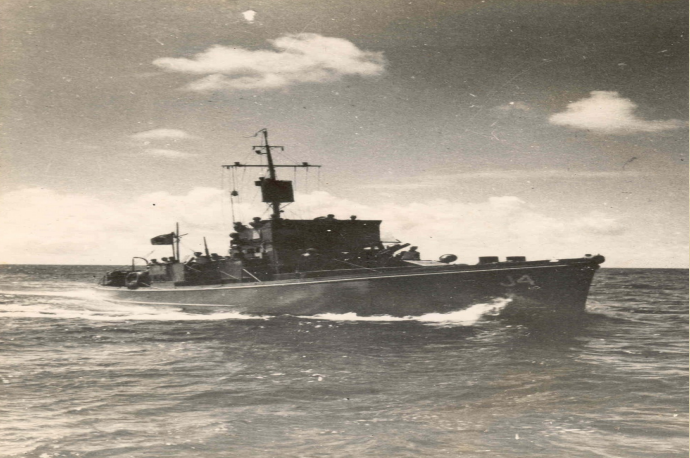BRAZILIAN NAVY NORTHEAST NAVAL FORCE *
15)SUB CHASER JURUENA CS 54


SC-497 Class Submarine Chaser
Laid down 9 April 1942 by W. A. Robinson, Inc., Ipswich, MA
Launched 27 October 1942
Commissioned USS SC-766 11 November 1942
Transferred to Brazil 31 December 1942 and renamed Juruena (CS 54)
Decommissioned 11 December 1951.
Struck from the Naval Register 1951.
Fate unknown.
Displacement 148 t
Length 110' 10"
Beam 17' 11"
Max. Draft 6' 6"(fl)
Speed 15.6 or 21k
Complement: 3 officers, 24 enlisted
Its armament consisted of a 3 ”(76 mm) and 23 caliber cannon, MK XIV from 1918, two 20 mm Oerlikon Its anti-aircraft machine guns, MK II; two rails for launching depth bombs from the stern, each with a capacity of four charges, four simple rails for launching depth charges from the edge, aft, and two simple mortars. The depth bombs were 135 kg and the ship was loaded with 20 charges.
Propulsion was done by two two-stroke diesel engines, eight cylinders in line, manufactured by General Motors, model 8-268A, each with power from 500 HP to 1,270 rpm, which moved two shafts and two propellers by means of reduction gears, which allowed to develop the maximum speed of 15 knots. Electric energy, in current continuous, was provided by two diesel generator sets, with 30 KVA and 20 KVA of power, respectively
For the underwater listening service, the ship was equipped with a listening device WEA-1, manufactured by RCA and a chemical recorder for distance. As to telegraph radio communications, the ship had a TCE-2 transmitter from Westinghouse Electric Co., with 125 W of phone power and CW, three receivers for short, medium and long waves.
History:
The ship was built in wood - American pine - with 100 caves, divided in three watertight compartments, separated by transverse steel bulkheads. The hull had a reinforcement of wooden boards called “ice shelting”, to allow the navigation in partially frozen waters.
For visual communications, the ship was equipped with flags, a hatch on themain mast, and a 12” searchlight. For navigation, the ship was equipped with two magnetic needles, one standard on the bridge and one on the footbridge, ACRM type radiogoniometer. The ship was equipped with a boat with a capacity for eight two cork rafts for eight men each and 25 life jackets
The "J" class was classified in the United States Navy as SUB-CHASERS (SC) and known in the Brazilian Navy as stick hunters (wooden hulls) in contrast to "G" Class iron fighters (iron hull). Armament was reasonable against submarines submerged, but insufficient for surface combat. Were employed in Brazil in services far superior to their own capacity. Their crews suffered great physical wear and tear because, although these ships had good stability, they rocked a lot, being very uncomfortable when they faced short swells in the Northeast, forcing, sometimes, their sleeping crews tied to the bunks.
The food was deficient, because in his kitchen, of small dimensions, the pots on the stove could not always be kept. The fresh water was only available for small quantities, for drinking and cooking, which increased crew discomfort, especially when escorting convoys of Trinidad to Recife or from Recife to Belém. The uniform was reduced to shorts and sandals. Officers' accommodation consisted of a small box of four bunks with a small bathroom.
During her stay in the active service, she sailed a total of 61,132 miles, escorting 37 convoys, totaling 257 days at sea. From May 1946, she was classified as a Lightship and carried out commissions to assist nautical signaling, to the Hydrography and Navigation Directorate
Between 8 and 12 Jun, the same Task Group joined one mixed Escort Group at the KG 638 Key West – Guantanamo Convoy. The train was composed by Merchants Suffolk, Cearalóide, APC-71, Rita, Oldhara, Gallant Fox, Juno, Coverbrook, Domino, Willian J. Bryan, Far and Robert Lowry. The screen also had the assistance of the USS SC 675, SC 656, SC 500, SC 1276, SC 1277 and SC 1034, USN.
On 13/Jun/43, Juruena J- 4, departed with the Task Group, also Brazilian-American in the escort of the Guantânamo Bay - Aruba - Trinidad (GAT 68)convoy, arriving in Trinidad on 19/Jun.
On 3/Jul/43 she left Trinidad to Brazil as part of one mixed group in the Trinidad – Recife (TJ 1)Convoy, arriving at Recife (PE) on 14/Jul/43